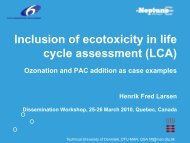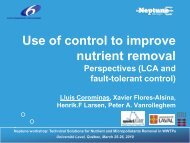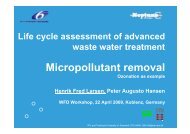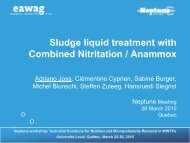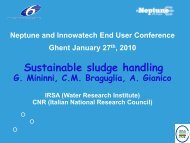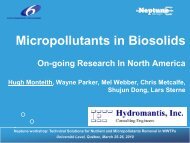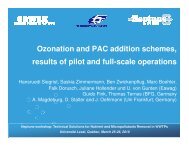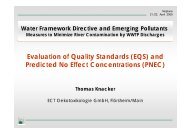D2.1 - EU Project Neptune
D2.1 - EU Project Neptune
D2.1 - EU Project Neptune
Create successful ePaper yourself
Turn your PDF publications into a flip-book with our unique Google optimized e-Paper software.
NEPTUNE · Contract-No. 036845 Deliverable 2.1<br />
room temperature. The results are given in Table 4.6. Neither the temperature nor the<br />
residence time had a strong influence on the solubility of the heavy metals in the solid<br />
residue.<br />
Table 4.6 Heavy metals leaching from the solid residue of sludge with 80% TS treated<br />
with ultra-high temperature pyrolysis (1gDS/20 ml de-ionized water, 5 days at 25°C).<br />
4.1.3 Potential for phosphorus and heavy metals recovery<br />
Phosphorus recovery, not only removal, is recognized as a long term goal in wastewater and<br />
sludge treatment, since phosphorus is limited and non renewable. According to Herter et al.<br />
(2001) easy accessible phosphorus resources will be depleted within the next 80 years.<br />
During wastewater treatment 40-95% of the incoming phosphorus is transferred into sewage<br />
sludge, depending of the technology applied (Berg, 2005). Phosphorus content in the<br />
stabilized sludge is in the range of 18-40 g/kgTS (Siegrist et al., 1989). Digested sludge<br />
treated by the ultra-high temperature gasification process in our experiments had Ptot<br />
content of 27 g/kgTS. The phosphorus content of the major solid product of the process, as<br />
well as heavy metals concentrations, is given in the following table. The maximum values<br />
allowed for fertilizers used in Germany and Austria are stated for comparison.<br />
Table 4.7 Heavy metals and phosphorus content of the solids residue as well as the<br />
maximum values allowed for fertilizers in some European countries (Adam et al., 2007)<br />
30



